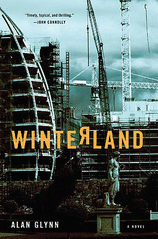 Gardiner lives in central Virginia with her husband, three kids, two dogs, one cat, and one gregarious parrot.
Gardiner lives in central Virginia with her husband, three kids, two dogs, one cat, and one gregarious parrot.Her new book, now available for pre-order, is Winging It: A Memoir of Caring for a Vengeful Parrot Who's Determined to Kill Me.
About two weeks ago I asked her what she was reading. Her reply.
I tend to be juggling several books at one time. The way my lifestyle is (driving kids to and fro, etc) I like to have something always at the ready, so I'll keep a book in my car, in the summer in my beach bag (for that rare chance to be at the pool), always one or two in my purse (lines at the grocery store are less painful if you can distract yourself with a book!). And of course I've got a book I read as I'm falling to sleep at night and I keep a book on my bathroom sink to read when blowdrying my hair/brushing my teeth. Don't laugh--I have so few moments in my day to just enjoy a book, I want to have one at the ready, just in case!Watch a video of Gardiner discussing Winging It, and learn more about the book and author at Jenny Gardiner's website and blog.
Now, this has all been made simpler and more complicated now that I have a Kindle. Which I LOVE, by the way. I apologize for those who take issue with Amazon--I empathizecompletely and do not like some of the business decisions they've made of late. But...being able to have a bazillion books in one teeny condensed square like that is fabulous. I can travel and have whatever I want at my fingertips, minus the bad back from lugging so many books along. I can feel somewhat less guilty for being responsible for the demise of vast stands of trees (somewhat). I can be lying in bed at midnight, hating the book I had started to read and not having another one handy, and in one minute I can purchase and download a new one! That's pretty damned cool.
Just the other day I heard of a book I needed to research something for a novel I'm working on. I was SO excited to pull over and order it for my Kindle. Only to be disappointed that it wasn't available as a Kindle book--boo!
I do hope that ultimately e-books will be available for purchase from all stores: indies, competing stores, etc, rather than having to make the purchase simply through one vendor. I think down the road this will be the case. We're in such early days with the whole e-book industry that a lot of vetting will occur until we get to that point...
That said, I have a LOT of tangible books in my TBR pile as well, so for the time being, rather than always having to find my Kindle and have it where I want it (a mild inconvenience), I'm still in the keep-books-everywhere mode. So currently on my Kindle I am reading a book by one of my new favorite authors and a new author friend, Ad Hudler, titled Househusband. It's a novel about a man who transfers to a new city when his wife gets a high-powered job, and in the midst of the transition decides to become a stay-at-home father to their young daughter. The perceptions and insights that Hudler brings to this novel so successfully bridge the gap between men and women, it really helps to portray the stay-at-home parent condition in such a clear light. He does so with snappy prose, amazing metaphors and similes and some awesome recipes to boot. It's laugh-out-loud but also has many poignant, insightful moments (so much so that I told him I think he's an Oracle!).The other book I finally picked up is another new author friend of mine--we've loosely known each other from Backspace, a wonderful online writers' group, for a few years, and met in person in January at Kathy Patrick's fabulous Pulpwood Queen's Girlfriends Weekend--Jamie Ford. His novel Hotel on the Corner of Bitter and Sweet is a touching, sweet story of unrequited love, of star-crossed friends torn apart by the cruel circumstances of time and history. It's an engaging read and feels so innocent and hopeful, it will keep you turning the pages.
In my to-be-read next pile are a number of Pat Conroy novels. I had the wonderful good fortune of meeting and talking at length with him at the Pulpwood Queens weekend as well, and found him to be such a charming, funny, engaging and thoughtful person. I don't tend to be one to seek signed books, but his I did for a number of friends and relatives. I have his latest, South of Broad, awaiting me, as well as his cookbook, of which I stole a few glances and can see the lovely raconteur in there, so can't wait to dig into. And I want to go back and read the books thatput him on the map: The Great Santini, Prince of Tides and Beach Music.
A fun fact about Pat Conroy: at this conference, he insisted on purchasing and having signed every book by every author in attendance (about 40). Now that's a classy guy.
The Page 69 Test: Sleeping With Ward Cleaver.
--Marshal Zeringue

















































